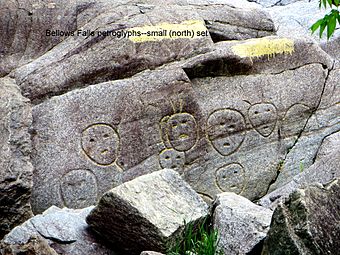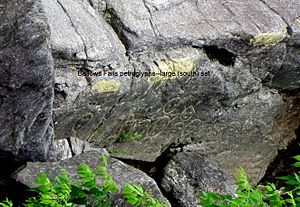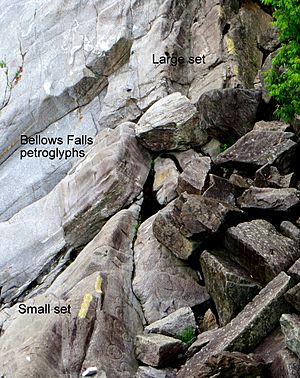Bellows Falls Petroglyph Site facts for kids
Quick facts for kids |
|
|
Bellows Falls Petroglyph Site (VT-WD-8)
|
|

Smaller set of petroglyphs, located 35 feet (11 m) south of the bridge. Photo was taken looking east from the road along the shore in the village of Bellows Falls.
|
|
| Lua error in Module:Location_map at line 420: attempt to index field 'wikibase' (a nil value). | |
| Location | Bellows Falls, Vermont |
|---|---|
| Area | less than one acre |
| MPS | Bellows Falls Island MRA |
| NRHP reference No. | 88002166 |
| Added to NRHP | January 22, 1990 |
The Bellows Falls Petroglyph Site is a special place in Bellows Falls, Vermont. It holds ancient rock carvings, known as petroglyphs, made by Native Americans long ago. These carvings are found on rocks near the Vilas Bridge, right above the Connecticut River.
What makes this site so unique? The carvings show human-like figures. These types of figures are very rare in New England and even in nearby areas. Because they are so special, the site was added to the National Register of Historic Places in 1990. This means it's an important historical place worth protecting.
Contents
What Are the Bellows Falls Petroglyphs?
The Bellows Falls petroglyph site is on the east side of Bellows Falls Island. It is just south of the Vilas Bridge. This bridge connects Bellows Falls, Vermont, with Walpole, New Hampshire.
Where Can You Find Them?
There are two main rock panels with carvings. One panel is about 35 feet (11 meters) south of the bridge. The other is about 55 feet (17 meters) south of the bridge. These carvings are right on the bedrock near the river.
What Do the Carvings Look Like?
Each rock panel has many figures carved into it. These figures look like human heads. They have mouths, eyes, and lines that spread out from them. The figures on the rocks are similar to the special corn husk masks. These masks were traditionally made by the Abenaki and Iroquois peoples.
The southern panel is about 5 feet (1.5 meters) long. It has eight carved figures. The northern panel is longer, about 10 feet (3 meters) long. It has sixteen carved figures. Sometimes, rocks piled up along the river bank, called riprap, help protect these carvings. Silt from the river can also cover and protect them.
Why Are These Carvings Special?
People have known about these carvings since the late 1700s. It's very rare to find similar figures in New England. However, some similar carvings have been found in Pennsylvania and parts of Canada. These are areas east of the Great Lakes.
Because these carvings are so rare, they help us learn about ancient connections. They show how different Native American groups might have shared ideas or traditions. This site gives us a special chance to understand the history of people in this region.



